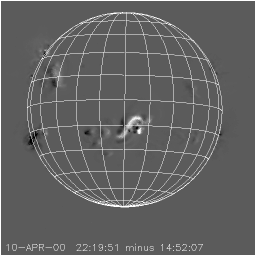
The solar corona often contains hot S-shaped structures. Curiously enough, these tend to look like actual S's in the South, but the mirror image in the North - rotate a mirror-image by 90 degrees, and you get something suspiciously similar to an N. Can the Sun be labeling its magnetic poles for us? Here is an example (from the South, as should be obvious):

For reasons of mathematical clarity, if not for the sake of pomposity, we call these structures "sigmoids" (neologism and other insights due to D. Rust), and we have found that they actually have a strong relationship with the tendency of an active region to erupt - to eject hot plasma violently, perhaps to make a coronal mass ejection (CME). We have often written Yohkoh science nuggets about sigmoids because SXT has a good view of them ( for example). Historically, the sigmoidicity (essedness?) of solar structures was well-known, and probably inspired Hale's discovery of solar magnetism (a big, big discovery) in the early 20th century. But the ones we see are a special set of sigmoids, because they are hot enough to emit soft X-rays. In one striking event, studied early as we began to learn about sigmoid behavior, A. C. Sterling found that the coronal sigmoid actually disappeared during the flare, leaving behind a bipolar structure similar to the one reported in the first science nugget, which incidentally shows the proper symmetry for an inverse North sigmoid (see also [1] or [2] ).
Another surprise! This week we clearly see a flare create a sigmoid, rather than destroy it; what's more we have a glimpse of how the creation is working. The time history below shows the occurrence of two C-class flares from NOAA active region 8948, the target of a major observing campaign with TRACE and SOHO. First, if you have large bandwidth, you could look at the MPEG movie of the hot compact sources in the flares. The plot below the movie icon shows the time history (in the icon itself, the first four frames come from the first flare, and the last four from the second):
where the yellow bars show where Yohkoh got flare-mode observations at high resolution (the field-of-view of the movie above is 2.5 arc min, a linear scale of about 50,000 km). We are in fact dying to see TRACE data with even higher resolution! But, in the second event, the Yohkoh lower-resolution data (field-of-view 5 arc min, or about 100,000 km) give us a view of something nice - the filling of a sigmoid structure from the end near the flare:
The spikes at the right (west) end of the sigmoid are saturation from the compact flaring region shown in the smaller field of view. Even the icon shows the sigmoid formation, and a difference image of whole-Sun images from before and after shows us the result:

Voila! The difference shows the sigmoid as white, because it's brightened; the compact flare region looks bright also because the embers remain hot.
In this nugget we've just seen the sigmoid in the act of creation, and it appears to consist of already-established field lines filled up by interaction with the flare itself. The obvious interpretations would be reconnection or inductive coupling between the small and large structures. In this case the sigmoid magnetic structure did not blow out to become part of a CME, even though in fact a CME observed by the LASCO coronagraphs accompanied this event. Interestingly enough, the SXT data do not readily show either a vast ejection, although one can see a sigmoid dimming feature in the difference image. But the ejection that we displayed above was kind of trapped in a stable structure (although it waved around a bit as it filled).
We hope to return to this new sigmoid in a couple of ways in future nuggets: first to learn what its ultimate fate was; and second, to see in glorious TRACE detail the phenomenon we've described. This is all pretty new and fascinating. See the recent Canfield et al. tutorial (.pdf, 2.8 MB, a big file!) if you want the background on solar sigmoids and eruptions.